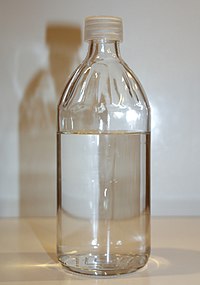
Photo from wikipedia
Ethanol is an important bulk chemical with diversified applications. Biomass derived ethanol is traditionally produced by fermentation. Direct cellulose conversion to ethanol by chemo-catalysis is particularly promising but remains a… Click to show full abstract
Ethanol is an important bulk chemical with diversified applications. Biomass derived ethanol is traditionally produced by fermentation. Direct cellulose conversion to ethanol by chemo-catalysis is particularly promising but remains a big challenging. We report a one-pot hydrogenolysis of cellulose into ethanol using graphene layers encapsulated nickel (Ni@C) catalysts with the aid of phosphoric acid (H3PO4) in water. The cellulose is hydrolyzed into glucose which is activated by forming cyclic di-ester bonds between the OH groups of H3PO4 and glucose, promoting ethanol formation under the synergistic hydrogenation of Ni@C. A 69.1% of ethanol yield (carbon mole basis) was obtained, which is comparable to the theoretical value by glucose fermentation. Ethanol concentration of up to 8.9 wt% was obtained at the increased cellulose concentration. This work demonstrates a chemo-catalytic approach for high yield and high concentration of ethanol production from renewable cellulosic biomass.
Journal Title: ChemSusChem
Year Published: 2019
Link to full text (if available)
Share on Social Media: Sign Up to like & get
recommendations!